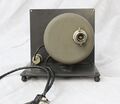1209-C: Difference between revisions
Jump to navigation
Jump to search
No edit summary |
No edit summary |
||
| Line 12: | Line 12: | ||
* Manual needed. | * Manual needed. | ||
}} | }} | ||
The '''General Radio 1209-C Unit Oscillator''' was introduced in | The '''General Radio 1209-C Unit Oscillator''' was introduced in {{Catalog R}} and remained available through {{Catalog S}}. | ||
The Type 1208-C is a general purpose frequency source covering 250 to 960 MHz. Direct amplitude modulation at audio frequencies is provided by a front panel phone jack and with an accessory crystal-diode modulator ([[1000-P6]] or [[1000-P7]]), frequencies from 0 to 5 MHz can be used to provide amplitude modulation. | The Type 1208-C is a general purpose frequency source covering 250 to 960 MHz. Direct amplitude modulation at audio frequencies is provided by a front panel phone jack and with an accessory crystal-diode modulator ([[1000-P6]] or [[1000-P7]]), frequencies from 0 to 5 MHz can be used to provide amplitude modulation. | ||
Revision as of 19:30, 2 April 2024
The General Radio 1209-C Unit Oscillator was introduced in Catalog R (1963) and remained available through Catalog S (1965).
The Type 1208-C is a general purpose frequency source covering 250 to 960 MHz. Direct amplitude modulation at audio frequencies is provided by a front panel phone jack and with an accessory crystal-diode modulator (1000-P6 or 1000-P7), frequencies from 0 to 5 MHz can be used to provide amplitude modulation.
Specifications
- Frequency Range: 250 to 960 MHz
- Frequency Calibration Accuracy: 1%
- Warmup Frequency Drift (Typical): 0.2%
- Output Power: 150 mW into 50 Ω with Type 1269-A Supply
Links
- Experimenter describing Unit Oscillators June 1965
- Experimenter describing Unit Oscillators August 1963
- Patent for the Butterfly Tuning Circuit
- 1209-C @ Fred PA4TIM's site










